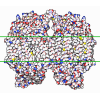[English] 日本語
 Yorodumi
Yorodumi- PDB-7cub: 2.55-Angstrom Cryo-EM structure of Cytochrome bo3 from Escherichi... -
+ Open data
Open data
- Basic information
Basic information
| Entry | Database: PDB / ID: 7cub | ||||||
|---|---|---|---|---|---|---|---|
| Title | 2.55-Angstrom Cryo-EM structure of Cytochrome bo3 from Escherichia coli in Native Membrane | ||||||
 Components Components | (Cytochrome bo(3) ubiquinol oxidase subunit ...) x 4 | ||||||
 Keywords Keywords | OXIDOREDUCTASE / proton pump / ubiquinol / oxidase | ||||||
| Function / homology |  Function and homology information Function and homology informationoxidoreduction-driven active transmembrane transporter activity / cytochrome o ubiquinol oxidase complex / ubiquinol oxidase (H+-transporting) / cytochrome bo3 ubiquinol oxidase activity / aerobic electron transport chain / oxidoreductase activity, acting on diphenols and related substances as donors, oxygen as acceptor / cytochrome-c oxidase activity / ubiquinone binding / electron transport coupled proton transport / proton transmembrane transporter activity ...oxidoreduction-driven active transmembrane transporter activity / cytochrome o ubiquinol oxidase complex / ubiquinol oxidase (H+-transporting) / cytochrome bo3 ubiquinol oxidase activity / aerobic electron transport chain / oxidoreductase activity, acting on diphenols and related substances as donors, oxygen as acceptor / cytochrome-c oxidase activity / ubiquinone binding / electron transport coupled proton transport / proton transmembrane transporter activity / ATP synthesis coupled electron transport / aerobic respiration / respiratory electron transport chain / electron transfer activity / copper ion binding / heme binding / plasma membrane Similarity search - Function | ||||||
| Biological species |  | ||||||
| Method | ELECTRON MICROSCOPY / single particle reconstruction / cryo EM / Resolution: 2.55 Å | ||||||
 Authors Authors | Li, J. / Han, L. / Gennis, R.B. / Zhu, J.P. / Zhang, K. | ||||||
 Citation Citation |  Journal: Proc Natl Acad Sci U S A / Year: 2021 Journal: Proc Natl Acad Sci U S A / Year: 2021Title: Cryo-EM structures of cytochrome reveal bound phospholipids and ubiquinone-8 in a dynamic substrate binding site. Authors: Jiao Li / Long Han / Francesca Vallese / Ziqiao Ding / Sylvia K Choi / Sangjin Hong / Yanmei Luo / Bin Liu / Chun Kit Chan / Emad Tajkhorshid / Jiapeng Zhu / Oliver Clarke / Kai Zhang / Robert Gennis /   Abstract: Two independent structures of the proton-pumping, respiratory cytochrome ubiquinol oxidase (cyt ) have been determined by cryogenic electron microscopy (cryo-EM) in styrene-maleic acid (SMA) ...Two independent structures of the proton-pumping, respiratory cytochrome ubiquinol oxidase (cyt ) have been determined by cryogenic electron microscopy (cryo-EM) in styrene-maleic acid (SMA) copolymer nanodiscs and in membrane scaffold protein (MSP) nanodiscs to 2.55- and 2.19-Å resolution, respectively. The structures include the metal redox centers (heme , heme , and Cu), the redox-active cross-linked histidine-tyrosine cofactor, and the internal water molecules in the proton-conducting D channel. Each structure also contains one equivalent of ubiquinone-8 (UQ8) in the substrate binding site as well as several phospholipid molecules. The isoprene side chain of UQ8 is clamped within a hydrophobic groove in subunit I by transmembrane helix TM0, which is only present in quinol oxidases and not in the closely related cytochrome oxidases. Both structures show carbonyl O1 of the UQ8 headgroup hydrogen bonded to D75 and R71 In both structures, residue H98 occupies two conformations. In conformation 1, H98 forms a hydrogen bond with carbonyl O4 of the UQ8 headgroup, but in conformation 2, the imidazole side chain of H98 has flipped to form a hydrogen bond with E14 at the N-terminal end of TM0. We propose that H98 dynamics facilitate proton transfer from ubiquinol to the periplasmic aqueous phase during oxidation of the substrate. Computational studies show that TM0 creates a channel, allowing access of water to the ubiquinol headgroup and to H98. | ||||||
| History |
|
- Structure visualization
Structure visualization
| Movie |
 Movie viewer Movie viewer |
|---|---|
| Structure viewer | Molecule:  Molmil Molmil Jmol/JSmol Jmol/JSmol |
- Downloads & links
Downloads & links
- Download
Download
| PDBx/mmCIF format |  7cub.cif.gz 7cub.cif.gz | 230.7 KB | Display |  PDBx/mmCIF format PDBx/mmCIF format |
|---|---|---|---|---|
| PDB format |  pdb7cub.ent.gz pdb7cub.ent.gz | 180.4 KB | Display |  PDB format PDB format |
| PDBx/mmJSON format |  7cub.json.gz 7cub.json.gz | Tree view |  PDBx/mmJSON format PDBx/mmJSON format | |
| Others |  Other downloads Other downloads |
-Validation report
| Summary document |  7cub_validation.pdf.gz 7cub_validation.pdf.gz | 1.3 MB | Display |  wwPDB validaton report wwPDB validaton report |
|---|---|---|---|---|
| Full document |  7cub_full_validation.pdf.gz 7cub_full_validation.pdf.gz | 1.3 MB | Display | |
| Data in XML |  7cub_validation.xml.gz 7cub_validation.xml.gz | 41.8 KB | Display | |
| Data in CIF |  7cub_validation.cif.gz 7cub_validation.cif.gz | 60.3 KB | Display | |
| Arichive directory |  https://data.pdbj.org/pub/pdb/validation_reports/cu/7cub https://data.pdbj.org/pub/pdb/validation_reports/cu/7cub ftp://data.pdbj.org/pub/pdb/validation_reports/cu/7cub ftp://data.pdbj.org/pub/pdb/validation_reports/cu/7cub | HTTPS FTP |
-Related structure data
| Related structure data |  30471MC  7cuqC  7cuwC  7n9zC M: map data used to model this data C: citing same article ( |
|---|---|
| Similar structure data |
- Links
Links
- Assembly
Assembly
| Deposited unit | 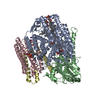
|
|---|---|
| 1 |
|
- Components
Components
-Cytochrome bo(3) ubiquinol oxidase subunit ... , 4 types, 4 molecules ABCD
| #1: Protein | Mass: 74424.469 Da / Num. of mol.: 1 / Source method: isolated from a natural source / Source: (natural)  References: UniProt: P0ABI8, ubiquinol oxidase (H+-transporting) |
|---|---|
| #2: Protein | Mass: 32249.971 Da / Num. of mol.: 1 / Source method: isolated from a natural source / Source: (natural)  |
| #3: Protein | Mass: 22642.566 Da / Num. of mol.: 1 / Source method: isolated from a natural source / Source: (natural)  |
| #4: Protein | Mass: 12037.402 Da / Num. of mol.: 1 / Source method: isolated from a natural source / Source: (natural)  |
-Non-polymers , 6 types, 22 molecules 

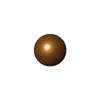
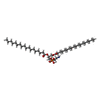







| #5: Chemical | ChemComp-HEM / | ||||
|---|---|---|---|---|---|
| #6: Chemical | ChemComp-HEO / | ||||
| #7: Chemical | ChemComp-CU / | ||||
| #8: Chemical | ChemComp-3PE / #9: Chemical | ChemComp-UQ8 / | #10: Water | ChemComp-HOH / | |
-Details
| Has ligand of interest | Y |
|---|
-Experimental details
-Experiment
| Experiment | Method: ELECTRON MICROSCOPY |
|---|---|
| EM experiment | Aggregation state: PARTICLE / 3D reconstruction method: single particle reconstruction |
- Sample preparation
Sample preparation
| Component | Name: Cytochrome bo(3) ubiquinol oxidase / Type: COMPLEX / Entity ID: #1-#4 / Source: NATURAL |
|---|---|
| Molecular weight | Value: 0.14 MDa / Experimental value: NO |
| Source (natural) | Organism:  |
| Buffer solution | pH: 8 |
| Specimen | Embedding applied: NO / Shadowing applied: NO / Staining applied: NO / Vitrification applied: YES |
| Vitrification | Cryogen name: ETHANE |
- Electron microscopy imaging
Electron microscopy imaging
| Experimental equipment |  Model: Titan Krios / Image courtesy: FEI Company |
|---|---|
| Microscopy | Model: FEI TITAN KRIOS |
| Electron gun | Electron source:  FIELD EMISSION GUN / Accelerating voltage: 300 kV / Illumination mode: FLOOD BEAM FIELD EMISSION GUN / Accelerating voltage: 300 kV / Illumination mode: FLOOD BEAM |
| Electron lens | Mode: BRIGHT FIELD |
| Image recording | Electron dose: 1.3 e/Å2 / Film or detector model: GATAN K3 (6k x 4k) |
- Processing
Processing
| Software | Name: PHENIX / Version: 1.18.2_3874: / Classification: refinement | ||||||||||||||||||||||||
|---|---|---|---|---|---|---|---|---|---|---|---|---|---|---|---|---|---|---|---|---|---|---|---|---|---|
| CTF correction | Type: PHASE FLIPPING AND AMPLITUDE CORRECTION | ||||||||||||||||||||||||
| 3D reconstruction | Resolution: 2.55 Å / Resolution method: FSC 0.143 CUT-OFF / Num. of particles: 193845 / Symmetry type: POINT | ||||||||||||||||||||||||
| Refine LS restraints |
|
 Movie
Movie Controller
Controller








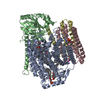
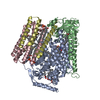
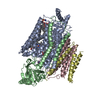
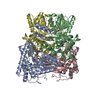

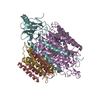
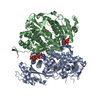
 PDBj
PDBj